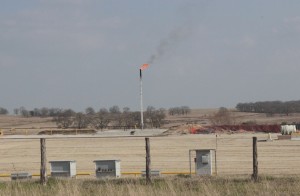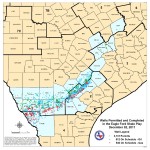Investigation Highlights Toxic Air Emissions In Fracking Fields
The fracking boom that has brought jobs and money to rural parts of South Texas has also brought potentially life-threatening air pollution. That’s according to a joint investigation out today from the Center for Public Integrity, the Weather Channel and Inside Climate News.
The report found that toxic chemicals like benzene and hydrogen sulfide are being emitted in increasing amounts in the Eagle Ford Shale area of South Texas.
“It’s as if you’d took a big oil refinery that you’d find in Houston and plopped it down in the middle of rural Karnes County, Texas,” Jim Morris, a reporter for the non-profit Center for Public Integrity, tells StateImpact Texas. The findings came from a review of state air pollution permits.
The investigation comes on the heels of an analysis, published recently in Science Magazine, that found that natural gas “production and processing” is emitting more methane than estimated by the Environmental Protection Agency. That has implications for global climate change, though the report found that methane leaks could potentially be fixed.
Rather than focus on greenhouse gasses, the investigation released today looks at toxic chemicals.
“There’s just no question that the chemicals are being released. The real uncertainty is, how bad is it?How bad is it going to be for people five or ten or twenty yeas down the road?” Morris asks.
But determining the exact nature of pollution in the region is difficult. That’s in part because the state regulator, the Texas Commission on Environmental Quality (TCEQ), hasn’t installed enough equipment.
“Even though the Eagle Ford Shale covers about 20,000 square miles, which is about twice the size of the state of Massachusetts — if you can picture that — there are only five permanent air monitors,” says Morris.

